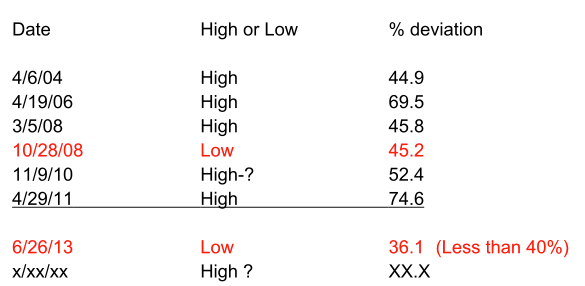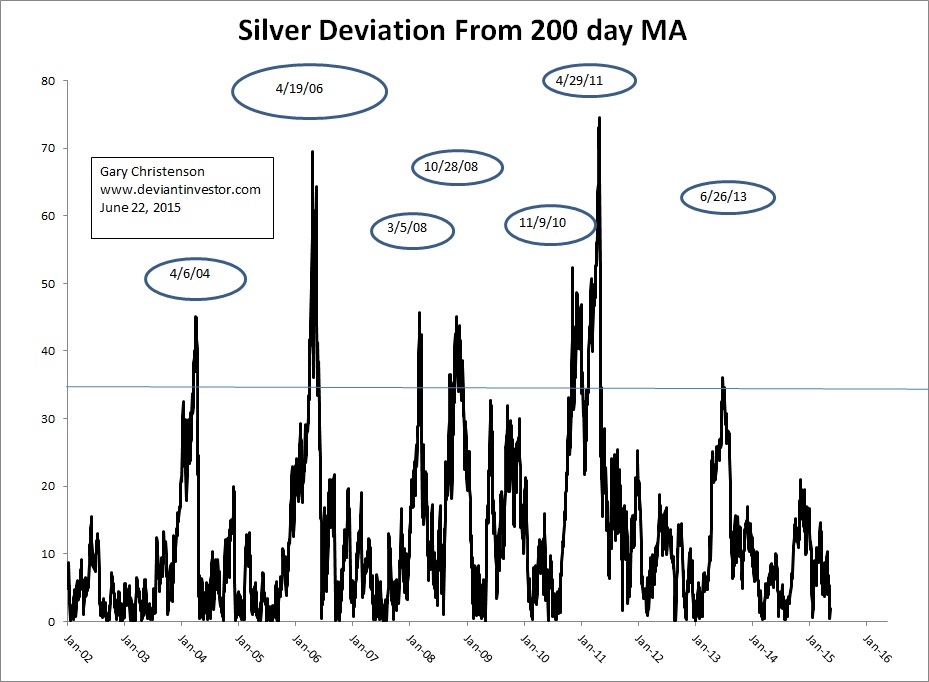Silver has moved sideways for about nine months, after it moved sideways from a slightly higher level for about 14 months. Boring!
The big events in the past 5 years have been:
- August 2010: Silver began a huge move from under $18 to nearly $50.
- April 2011: Silver hit a 30-year high just under $50.00.
- May 2011: Silver crashed to about $34. HFT left fingerprints at the scene.
- January 2013: Silver dropped below $30.
- April 2013: President Obama met with a group of influential bankers in the White House. The price of silver crashed the next day and by June silver had dropped to about $19. (If it happens in politics, it was planned…)
- November 2014 & March 2015: Silver made a double-bottom at about $15. Few noticed.
Very little has happened in the silver market, other than a developing bottom in prices, since the High Frequency Traders and Wall Street bankers crushed the silver market between April and June two years ago.
To quantify the volatility the following chart shows the (absolute value of) percent deviation from silver’s 200 day moving average. A spike higher or lower is volatility. The six spikes in volatility above 40% deviation from the 200 day moving average are quite large.

The spikes in volatility occurred several years apart and were usually separated by periods of low volatility. Two and one half years from the smaller spike in June 2013 is approximately October 2015 to March 2016. Volatility is coming, sooner or later.
SUMMARY:
Silver prices have shown little volatility for the past four years. Future volatility is likely.
Silver prices have peaked in volatility in 2004, 2006, 2008, and 2011. The next peak could occur soon, perhaps in 3 to 9 months.
Historically, silver has been boring and non-volatile for 80-90% of the time, and exciting and highly volatile, either spiking higher or crashing, for 10 – 20% of the time.
Silver is currently priced at about $16, down about 2/3 since its April 2011 high. A double bottom occurred in the past nine months. Silver is more likely to make a major move higher than crash to a lower low.
WHAT COULD CAUSE A PEAK IN PRICES AND VOLATILITY?
Many unstable conditions exist. Here are a few that could propel silver prices much higher.
The world has over $200 Trillion in debt, which is growing rapidly and exponentially. This does not count unfunded liabilities and derivatives. Debts must be paid or defaulted. Paying that debt is more problematic each day, while default becomes more disastrous each day. Silver and gold have no counter-party risk, in contrast with the $200 Trillion in debt that has value only if it is expected to be repaid. But repayment is problematic unless you believe that debt can increase forever. I don’t.
We saw the consequences of a loss of confidence in currencies and liquidity in the 2008 financial crisis. Since then the world has substantially increased total debt, increased leverage, reduced interest rates, and added to the collection of derivatives that increase bank profits until an “accident” happens. There is much that can go wrong in a highly leveraged and excessively indebted system based on fiat paper currencies that are created by many central banks. Would you rather hold real silver or fiat paper debt issued by a dodgy government denominated in a sure-to-be-devalued currency?
We are in the midst of simultaneous bond, equity, and currency bubbles. A bubble will not expand forever. Predicting the deflation date may not be possible but knowing that bubbles always pop should encourage wealth to gravitate to silver and gold, as well as NY apartments, fine art, real estate and private vaults.
The Chinese and Russians have aggressively purchased gold since the 2008 financial crisis. They wanted real assets not denominated in fiat currencies issued by profligate governments. Do they see the financial world more clearly than the Federal Reserve and the State Department?
Greece can NEVER leave the EU, or Greece MUST leave the EU, depending on who is talking. Might something go wrong fairly soon and increase the volatility of real assets such as silver and gold?
Countries in the EU must have “bail-in” legislation in place by the end of July or face legal action. Bail-ins would not be necessary if the financial system was sound and well capitalized. Of course we know it is neither sound nor well capitalized and accidents happen. Who will want fiat money rather than silver or gold during an “accident?”
Middle-East wars, South China Sea conflicts, Ukrainian conflicts, and other wars could destabilize the world financial system. If that occurs, confidence in currencies and debt will erode rapidly and there might be another rush into hard assets for protection.
CONCLUSIONS:
Volatility in silver prices has been low. Periods of low volatility have always been followed by periods of high volatility.
The most likely increase in silver volatility is a price spike much higher.
There are many financial and political instabilities that could drive silver prices far higher.
The next 6–9 months should be dangerous and volatile for most asset classes. Silver looks like a far better choice than bonds or equities at this time.
Buy gold, buy silver, have faith! (Darryl Robert Schoon)
